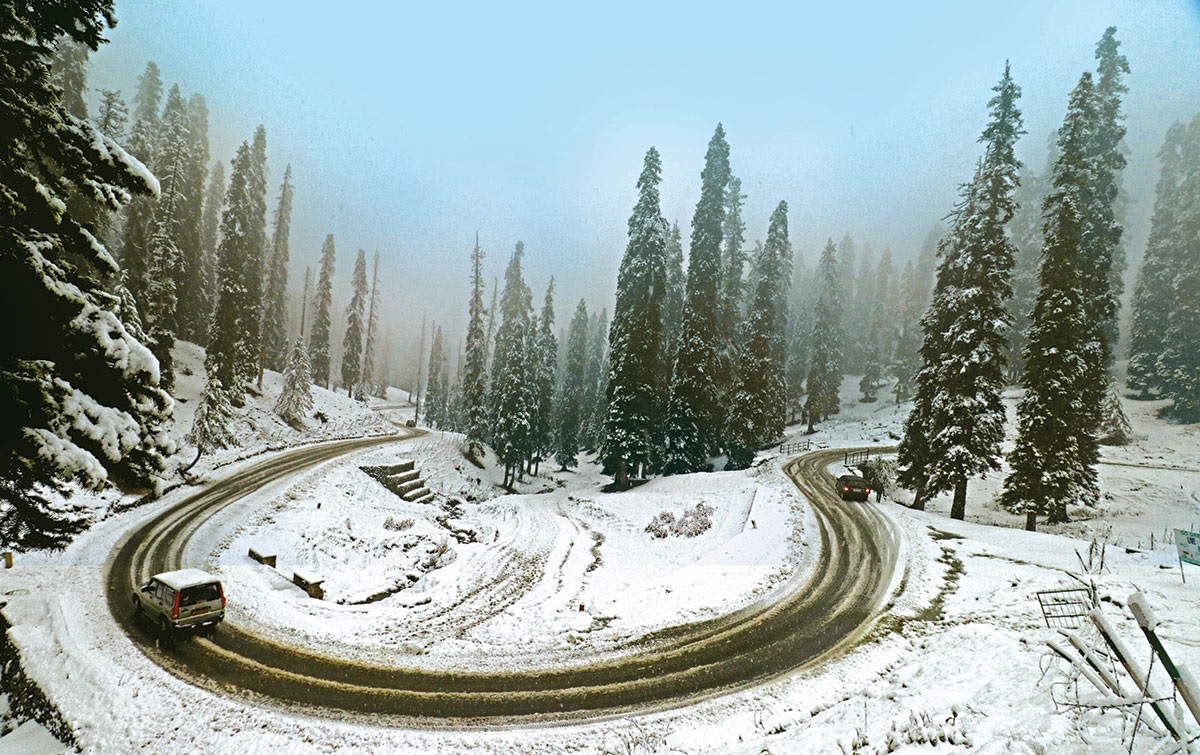Record rush to the Hindu cave shrine has been complimented with record deaths this year. Permitting massive crowds on the treacherous track could trigger a repeat of 1996 when over two hundred pilgrims died. R S Gull examines how the SASB is ignoring recommendations of an MHA penal to which the Board owes its existence.
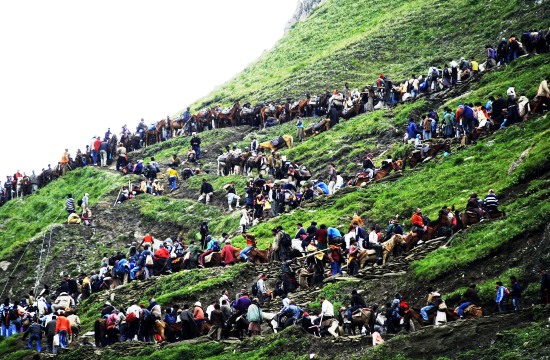
The pilgrim rush to Amarnath has already crossed half-million mark and the yatra will continue for another fortnight before closing this year. Everyday an average of around 20,000 pilgrims trek up the twin tracks leading to the Hindu cave shrine.
“The rush of the pilgrims to Amarnath this year and inadequate crowd control at critical points along the trekking route to the holy cave in Kashmir are leading to dangerous overcrowding on the narrow mountain trails near the ice shrine, increasing the risk of a stampede that could put hundreds of lives in danger,” reported Times of India, on its front page last week from Baltal.
“Half-an-hour after starting out for the shrine from Panchtarni, which is 6 kms from the holy cave, we were trapped in a jam for close to two hours. There was not an inch of space on the path. There was pushing and shoving as yatris got restless. A sudden movement of a horse or commotion in a section of the crowd could have caused a big stampede,” Pankaj Dutta, a student from Guwahati, told the TOI.
For most of the initial week of yatra, police officers posted at the ice shrine said, there was a 4-kms long queue of pilgrims waiting for darshan. Both security personnel on duty in the area and experts agree that this number is way above the safe limit. For most of the day it is chaotic up on the slopes.
Yatra began as a smooth affair on June 29. Three days later massive rains lashed the tracks and at a few places there was a light snowfall, weather gods have been favourable to Shiva. But pilgrim deaths along the tracks to the shrine were continuously coming in. Sources in SASB said so far 71 pilgrims died, the highest number ever.
It is Amarnath’s new record that no one can be proud of. “It is a huge number of deaths,” a middle rung SASB official said. “We had only 59 deaths in 2008 and 68 in 2010 for the entire yatra of two months.” Most of the deaths take place not because of cold but because of the cardiac arrest and severe breathing problems in an oxygen-deplete high altitude atmosphere. This despite a number of medical camps and doctors with allopathic and ayervedic specialisations stationed at various places along the twin-tracks by the J&K government.
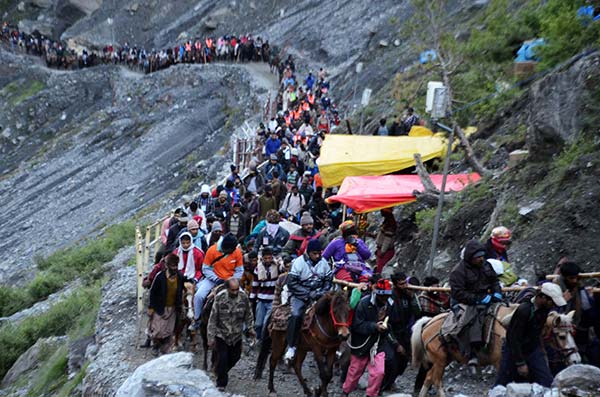
The SASB efforts to control the crowds seem half hearted. “No person who has a serious medical or orthopaedic ailment, or any breathing, chest or heart problem should think of undertaking this arduous yatra,” said SASB CEO, R K Goyal, in a routine daily appeal to the pilgrims, adding the pilgrimage involves climbing up to nearly 14,000 feet above sea level. But it has had no impact on the hoards of pilgrims who come without mandatory registration slips. Even the security men posted at the base camps at Baltal and Pahalgam are trying their bit but they cannot decide on behalf of the SASB. Privately, SASB officials say they cannot prevent people from going on the pilgrimage.
Such is the rush that governor N N Vohra, who heads the SASB, had to direct the CEO to “immediately provide additional toilets at Sheshnag, Panjtarni and in the Holy Cave area, keeping in view the number of pilgrims who had visited these three camps.” The SASB had planned the temporary infrastructure including tents and toilets on basis of the averages of the last couple of years but the numbers surged dramatically this year.
This has created a tricky situation that could turn ugly and disastrous as happened in 1996. Then, the government (the SASB came into being later) had made the preparations for receiving around 70,000 pilgrims. But it turned out that there was almost twice that number hitting the ice shrine. And then the weather gods turned hostile as the track registered a sharp fall in temperature and snowfall all along.
The militants during that period would routinely announce ban on the yatra. They would even ask the officials to get dissociated from the exercise, something that never happened. This, however, eventually would make the state security establishment quite reactive and over-protective. Though it had no impact on the mass participation of the locals but that year the security establishment did not permit the local dhabawallas, tent agencies and other locals to move up beyond Chandanwari.
“I had a good aerial view of the route, just a pathway, where only one or two persons could travel along side,” Dr Nitish K Sengupta wrote in his huge report in December 1996 after he was asked by the MHA to probe into the tragedy that devoured 243 souls, mostly pilgrims and 25 local porters. “One could imagine how horrible things must have been between August 21 and August 26 (1996) with about 70000 stranded pilgrims struggling to get out along this narrow, slippery, highly hazardous pathway in the midst of heavy snowfall and high wind velocity.”

Currently heading Board for Reconstruction for Central Public Sector Enterprises, Dr Sengupta is one of the illustrious members of the IAS fraternity. After studying history in Presidency College, Kolkotta, he joined the IAS in 1957 and held some vital positions including the union Revenue Secretary, Member Secretary, the Indian Planning Commission and represented India in the UN Commission on Trans-national Corporations of which he was elected as Chairman 1981-82. He did his PhD in Management from Delhi University and later in 1992 became Director General, International Management Institute and changed its status and profile. He was a Lok Sabha member and has had a series of post-retirement assignments.
An author of many books, Sengupta headed the penal that probed the 1996 Amarnath tragedy and it was one of his recommendations that led to the setting up of SASB in 2000.
“Many succumbed to death either because they got tired in course of continuous trekking, sat down and frozen to death or because some of them just slipped down to the deep ravines due to stampede at many points and the crisscross movements of ponies that created a lot of disorder,” Sengupta recorded in his report on basis of the representations he received and the meetings he had with the survivors of the terrible snow blizzards. “Visibility was poor and there was pitch darkness at night. Many people are reported to have frozen to death on the glacier outside the holy cave.”
The unexpected arrival of the hoards of pilgrims did not skip the panel’s scrutiny. The report recorded: “Many of the political groups, both inside the state and from outside, send contingents to the yatra in order to make it appear that things were returning to normalcy. Eventually, the crowd that came was much larger than what had been projected by the state administration.”
Year 1996 was not an ordinary year. It was the first election after Dr Farooq Abdullah had resigned in 1990 in protest against Jagmohan’s appointment as the governor of J&K. The year replaced a comparatively longer spell of the Governor’s rule in the state with Dr Farooq’s National Conference sweeping the show that was dominated by the security forces.
This year, for the second time, the ice shrine is attracting massive crowds. It has already created a record. In absence of a report, it is difficult to link the crowds with the peaceful summer in Kashmir for the first time since 2008. In fact the summer disturbances owe their basics to the land row involving SASB then led by Lt Gen (retd) S K Sinha.
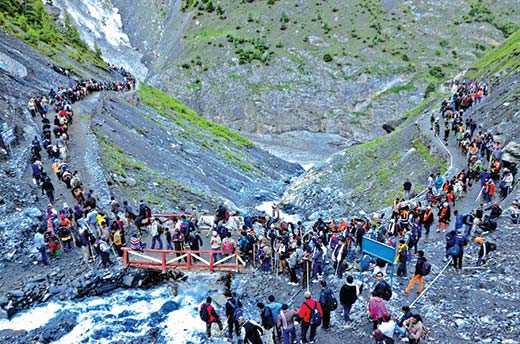
But the real issue is what Sengupta has suggested for conducting the Hindu pilgrimage. His emphasis throughout the report has remained on the numbers. “It has to be emphasised here that the carrying capacity of this pathway of about 32 kms is extremely limited,” the report says, adding, it provides “strong grounds for controlling the number of pilgrims, whether walking or riding on ponies, at any point of time.”
Sengupta was working on a presumption that one lakh pilgrims would be visiting the cave shrine in 30 days. He believed that given the treacherous route, there have to be “at least 1.5 to 2 supporting staff” – horsemen, porters and tent-owners and langarwala for every pilgrims that is permitted to climb the steep track. “On a rough reckoning, I would suggest 10,000 pilgrims per day,” adding, “In other words beyond Chandanwari, on any day, there should not be more than 10,000 pilgrims.” Sengupta believed “in any case Pahalgam can not accommodate more than 12 to 15,000 persons.”
Frustrated with not a single department of the J&K government being directly responsible for conduct of yatra and lack of adequate funding (state government spent Rs 85 lakhs in 1996), Sengupta strongly argued that a separate board needs to be set up for managing the yearly month long affair. He offered a system as well. “It was repeatedly stressed that the Amarnath yatra should be organized on the pattern of the Haj pilgrimage by properly scrutinizing each pilgrim and issuing permits to undertake hazardous journey, on the lines of the annual pilgrimage to Kailash and Mansarovar that is organized with the help of Chinese authorities,” his report reads.
“In both the cases the numbers are regulated. Passes are issued to each pilgrim after a thorough medical check-up and verification as to whether the pilgrim is medically fit to undertake a hazardous journey,” it said.
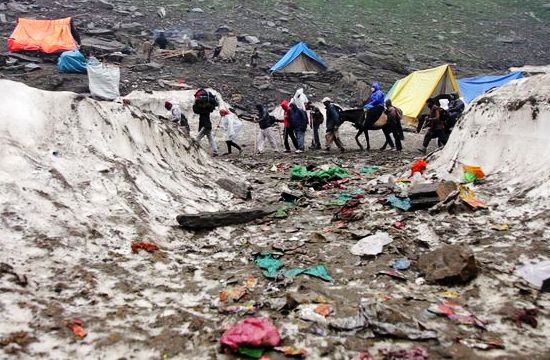
Sengupta suggested a registration certificate should be issued to each applicant who satisfy the requirements. A service charge should be made and part payment for accommodation should also be made payable as in the case of Haj pilgrimage and the pilgrimage to Kaislash and Mansarovar.
Understanding the location of the shrine and the tough terrain one has to pass through, Sengupta emphasized that the “pilgrimage to Amarnath is not just a pilgrimage but high altitude mountaineering.” It is therefore absolutely essential that those who proceed there must have arrangements for a shelter over their head at night and adequate winter clothing. He categorically ruled that people below the age of 15 and above the age of 65 or so should not ordinarily be encouraged to travel to Amarnath. “All pilgrims should furnish a medical certificate that they are fit to undertake this hazardous journey,” the penal suggested.
The former administrator was clear in his mind that the trekking to the shrine involves a fragile ecology. He suggested restrictions on indiscriminate performance of the Havans at the cave. “These Havans pollute the purity of atmosphere and also constitute fire hazard,” it said. The penal wanted immediate ban on “drunkenness by a section of the yatris” because it is not good for the pilgrimage, it impacts health and safety of the pilgrims and it is not approved by local customs.
Sengupta did receive “complaints of unsanitary conditions caused by the performance of morning abulations by the larger number of yatrsis without any restrictions as to the area where these should be done.” This, he said, destroys the pristine purity of the atmosphere besides triggering the danger that these unsanitary practices infect drinking water sources. “It is reported that even in normal years, there is significant casualty from infectious diseases,” the report mentions, adding, “Some degree of hygienic conditions should be ensured at various bhandaras, especially with regard to disposal of waste by the Sadhus.”
Assessing the role of the host population in wake of the crisis, Sengupta wrote in details in his report. “The true hero’s during the first few days were the Kashmiri villagers who spontaneously took up rescue and relief work sharing their rooms or tents and their food with the distressed,” the report reads. “They offered them the food and clothing and shred their own room or tent with the yatris.
No case of eve teasing was reported and in fact the women were treated with a lot of honour and dignity. Some organizations in these villages also came to help yatris by providing them food as well as shelter. Even a militant group was reported to have run a free langar. This aspect of the 1996 yatra is commendable and needs appreciation.” The report adds: “These points need to be highlighted and projected to all those who have a tendency to question the secularism and patriotism of the Kashmiri people.”
The report, however, did admit that there was profiteering. “…but except for the raising of prices of services and goods by shopkeepers and other residential owners which was inevitable due to normal law of demand and supply, there is no other complaint of harassment whatsoever,” the report says.
Given the load on the twin tracks to the cave, the risk of a 1996-like tragedy gets multiplied many times. At any point of time, there are more than 30 thousand people at one or the other place on the two sides. “It is not a trickle or a line,” said a police officer on condition of anonymity. “It is a procession.” Any halt and a disruption can trigger a crisis especially if weather conditions turn hostile.
The SASB sources say they are making efforts. They have been running consistent campaigns in the mass media that pilgrims should avoid the pilgrimage if they are medically unfit. They have registered pilgrims in anticipation but within days they permitted hoards of pilgrims who were never registered. Efforts are there but why is the SASB not asking the law enforcement agencies to implement the decisions. Is the Raj Bhawan waiting for a disaster to happen?







